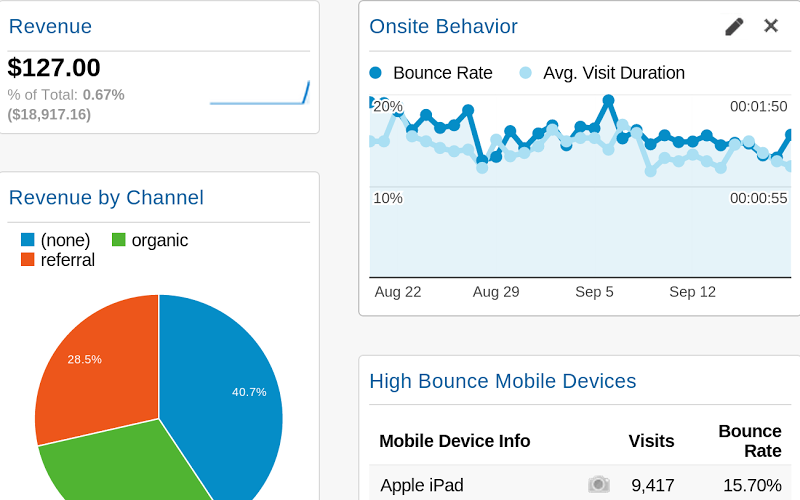In the age of internet purchasing, convenience shopping, and click and collect, spending money online is getting easier and easier. For consumers, the speed at which a products can be purchased without ever leaving our house and turn up at our door the next day has helped eCommerce gain an even larger foothold in the shopping industry.
For business owners, tools are readily available to help them set up an easy-to-use and maintain online store in no time at all. But just building the store doesn’t mean customers will visit your store, let alone buy. Getting an eCommerce website up and running is only half the battle. The key to a successful eCommerce business is a well-planned eCommerce strategy based off of data-driven decisions.
What data should you be looking for and how can you use that data to make the right decisions for your online storefront? You’ll want to make sure you’re using the data tailored specifically for eCommerce growth and success to help you increase conversion rates and the overall customer retention.
Drive Traffic to Your Site with Search Engine Optimization (SEO)
 You’ve probably heard about how important SEO is for online success. SEO tells search engines like Google that your site has relevant, detailed, and helpful content, and can help you target keywords and drive organic desktop and mobile traffic to your site.
You’ve probably heard about how important SEO is for online success. SEO tells search engines like Google that your site has relevant, detailed, and helpful content, and can help you target keywords and drive organic desktop and mobile traffic to your site.
If you’re at all skeptical, take a look at how big a role search engines play in eCommerce:
- Search is the #1 driver of traffic to content sites, beating social by 300%
- 61% of global internet users research products online
- 44% of online shoppers begin by using a search engine
- SEO leads have a 14.6% close rate, while outbound leads (e.g. direct mail or print advertising) have a 1.7% close rate
Implementing on-page SEO best-practices is both an art and a science, but there are guides on how to get started optimizing your site.
Analyze Your Traffic with Google Analytics

Source: Google
One of the most important skills you can have to help you make data-driven decisions is learning how to effectively use Google Analytics. Google Analytics tell you how site visitors arrive at your site, their browsing behavior, when they drop off, and your site’s overall performance.
Additionally, it also has an eCommerce Tracking tool that allows you to collect and analyze purchase and transaction data, such as product and transaction information, average order value, eCommerce conversion rate, and how long it takes to make a purchase.
With this information, you not only have a greater understanding of what is motivating visitors to buy, you also have valuable data on what is causing them to not buy. From there, you can adjust your performance accordingly to provide a greater online experience before, during, and after the sale.
Target More People with Google AdWords
Internet marketing has helped with precisely targeted advertisements. Where SEO targets organic search traffic, paid search allows you to bring your site to the top of search result pages and stand out from other sites that may have a stronger SEO strategy than yours.
The benefits of a paid search strategy is that it is much more targeted than traditional ads (e.g. tv, radio, print), and its reach and click-through rate (CTR) can be measured. This data can help you adjust your ad’s messaging to better optimize your performance and push your advertisements in front of an audience more likely to be interested in your products and services.
Google AdWords can help you manage your ad and define your target, all the while working within any sized budget.
Remarket with Google Display Network
This has probably happened to you: you were browsing an online clothing store and found a few shirts that you really liked but didn’t want to commit to making a purchase just yet. You leave the store and click through other sites not related to your shopping pursuits. Nonetheless you’re seeing ads for the clothing store or the shirt you were previously looking at everywhere and they’re constantly reminding you that shirt you really, really liked was still waiting for you. Even days later you’re still seeing that shirt. It’s like they know you.
That’s the power of remarketing, typically from Google’s Display Network tool. Google’s Display Network lets you display your ads on other sites, especially those that might be more popular than your own. Visitors who previously bounced from your site without making a purchase are reminded of your products or services on other sites, which encourages them to return to your eCommerce store to complete the buyer’s journey.
Like AdWords, the Display Network can fit any sized budget while helping you increase volume of clicks and conversions, generate reports to provide insight into your campaign’s performance, and allow you to adjust your campaign keywords and settings for improved results.
Not sure where to start?
There are tons of tools and best practice strategies out there for optimizing your eCommerce site, and there isn’t always a one-size-fits-all model that works for all industries or businesses.
Logic’s eCommerce strategy team of Digital Marketing Specialists and development experts can help you navigate these waters, select what works for your store, and help you track, analyze, and adjust your performance. You can count on us to help you strategize the best way to reach your customers.
